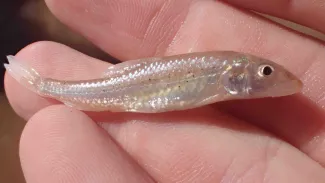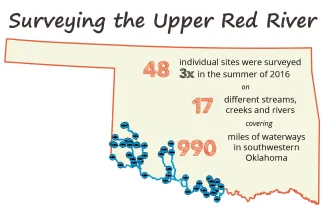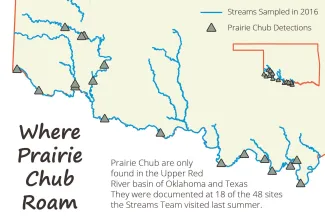The prairie chub, a fish species of greatest conservation need, was documented in an extensive survey of the Upper Red River conducted by the Wildlife Department's "Streams Team." Learn more about their survey effort in another Outdoor Oklahoma Journal entry, "Red River Research."
The fish found in Oklahoma’s prairie rivers are survivalists. They eke out an existence during hot summers when rivers and streams often go underground, and they resurface when flows increase after a rain event.
While theirs is a risky lifestyle, Oklahoma’s native fish are well-adapted to these flood-prone rivers and streams.
The Oklahoma Department of Wildlife Conservation Streams Team’s recent sampling of the Upper Red River revealed an unmistakably resilient population.
Species considered to be of greatest conservation need, such as the prairie chub, were documented in the Upper Red River and some of its major tributaries two years after an extensive drought, when several western Oklahoma streams went dry.

The prairie chub is among 17 species of greatest conservation need that were documented by the Streams Team.
Prairie chub are only found in the Upper Red River basin that crosses the southwestern part of the state and parts of northwestern Texas. Breeding, or spawning, season for this species can extend from early spring to late summer, and biologists theorize the fish use the river’s erratic flows to their advantage.
The bulk of prairie chub seem to synchronize spawning efforts in times of high flow, broadcasting their semi-buoyant eggs into the current to be carried downstream. Without the current, the delicate eggs could settle on the sandy river bottom and become buried.
By using the water’s current to keep the eggs afloat, the prairie chub help their eggs and larvae reach the relatively safe edge or backwaters of the river, where conditions are more favorable for the young fish’s development.
Other than the fact that prairie chub are restricted to braided rivers and streams of the Southern Great Plains, little else is known about this small fish.
To get a better understanding of where prairie chub can be found and how many may be schooling in the mostly shallow river, the Wildlife Department has partnered with Richard Broughton, a biologist and professor with the University of Oklahoma.
In addition to learning where this species can be found, Broughton is also interested in how these fish are genetically different from a sister species: the shoal chub. The two species hybridize where their ranges overlap, but the extent of hybridization is not clear.
Last summer, prairie chub were documented at more than 35 percent of the sites monitored as part of the Streams Team’s Upper Red River community sampling efforts. While the biologists were concerned about the absence of prairie chub in the upper reaches of the Salt Fork of the Red River, they were encouraged that most of the chubs captured were fish that had hatched earlier that summer, which are called young-of-the-year fish.


This high proportion of young-of-the-year fish in the survey indicates the population is indeed rebounding in some areas after the drought.
Samples collected during the Streams Team’s surveys will be shared with Broughton to help strengthen his data and shed more light on this species of greatest conservation need. The work should show how genetically similar prairie chubs from one tributary are from the main stem of the Red River. The more similar the samples are, the more likely that the fish are undergoing long-distance migrations for spawning.